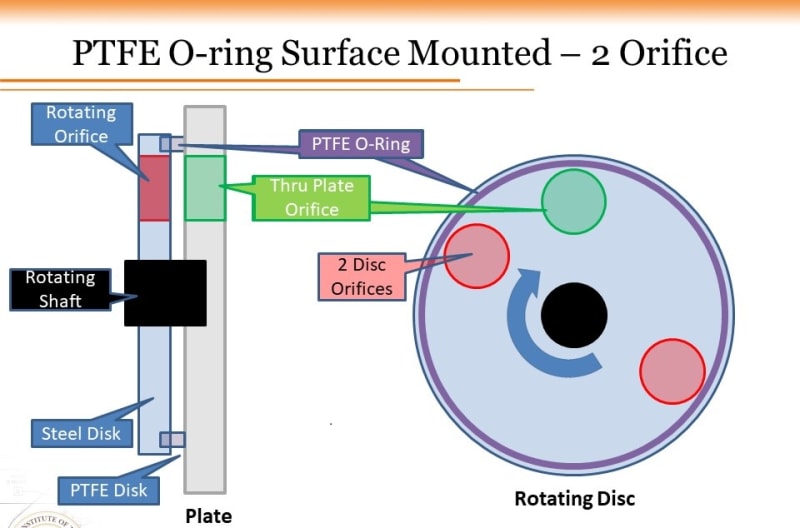jrkeme
Mechanical
- Jan 17, 2024
- 12
OK I'll try to keep this brief.
I have an application that is meant to diminish (not seal) leakage from a 50-100psi vessel around a 5 inch rotating disc out an orifice. So within the pressure vessel is a 1 inch rotating shaft with a 5 inch disc mounted to it. The disc at the moment is right up against the end cap housing. We tried to get a very small clearance but it still leaks too much. So this rotating disc that is right next to the end cap of the pressure vessel is rotating with 2 holes in it. As the holes rotate they uncover an orifice in the end cap (that is what they are supposed to do) However since we do not have sealing around the outside of the disc there ALWAYs a permanent leackage path to the orifice in the end cap. What we want is for higher pressure air to only go through the orifice when one of the two holes in the disc align. Not that PLUS the leakage around the disc.
SO! What I am looking for is not shaft sealing. What I would like to do is put an "o-ring" or equivalent around the perimeter of the disc so that when the disc is pushed up against the end cap (recall we tried to do 0.010") there is some type of sealing mechanism. So think of the disc as a hamburger with a 5 inch onion ring around the perimeter that is "compressed against the end cap. I am very ok with this NOT being a actual full seal. It can be a clearance seal that as the "material" wears due to "break in" the remaining gap is very tiny. This is my cave man view of what I think will work. ESPECIALLY Since what I would like does not seem to exist. Keep in mind I cannot easily put a "lip seal" around the circumference of the 5 inch disc against the radial part of the housing. That gap is greater than 1 inch.
Does something like this exist? To conclude I am expecting some leakage. Is there a consumable part/ring that I could install into the rotating disc that when pushed up against the end cap I get an effective seal to leakage around the outside of the disc. So really my onion ring is fully in contact with the end cap at all times. I was thinking of something made of PTFE or carbon?
Thanks everyone
Jason
I have an application that is meant to diminish (not seal) leakage from a 50-100psi vessel around a 5 inch rotating disc out an orifice. So within the pressure vessel is a 1 inch rotating shaft with a 5 inch disc mounted to it. The disc at the moment is right up against the end cap housing. We tried to get a very small clearance but it still leaks too much. So this rotating disc that is right next to the end cap of the pressure vessel is rotating with 2 holes in it. As the holes rotate they uncover an orifice in the end cap (that is what they are supposed to do) However since we do not have sealing around the outside of the disc there ALWAYs a permanent leackage path to the orifice in the end cap. What we want is for higher pressure air to only go through the orifice when one of the two holes in the disc align. Not that PLUS the leakage around the disc.
SO! What I am looking for is not shaft sealing. What I would like to do is put an "o-ring" or equivalent around the perimeter of the disc so that when the disc is pushed up against the end cap (recall we tried to do 0.010") there is some type of sealing mechanism. So think of the disc as a hamburger with a 5 inch onion ring around the perimeter that is "compressed against the end cap. I am very ok with this NOT being a actual full seal. It can be a clearance seal that as the "material" wears due to "break in" the remaining gap is very tiny. This is my cave man view of what I think will work. ESPECIALLY Since what I would like does not seem to exist. Keep in mind I cannot easily put a "lip seal" around the circumference of the 5 inch disc against the radial part of the housing. That gap is greater than 1 inch.
Does something like this exist? To conclude I am expecting some leakage. Is there a consumable part/ring that I could install into the rotating disc that when pushed up against the end cap I get an effective seal to leakage around the outside of the disc. So really my onion ring is fully in contact with the end cap at all times. I was thinking of something made of PTFE or carbon?
Thanks everyone
Jason

